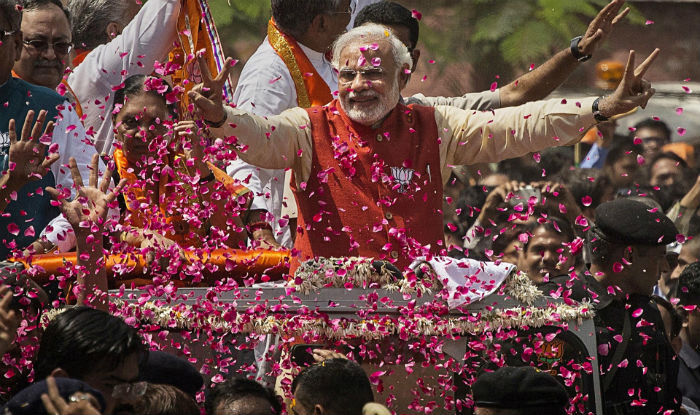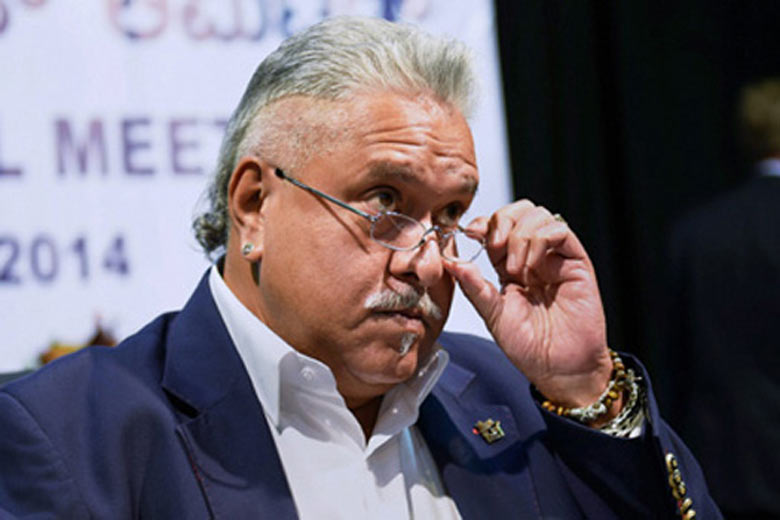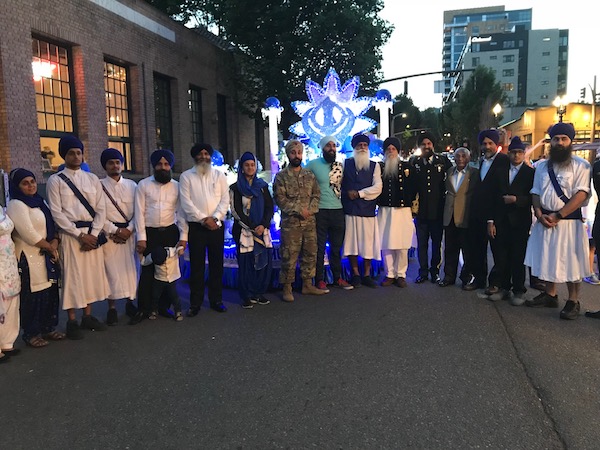
Will Modi be India’s Gorbachev?
 Remember, Gorbachev, a modern man heading a medieval Communist Party, introduced Glasnost (Transparency), without exactly working much for Perestroika (Reconstruction) in the 1985-91 era. The result was the dissolution of the “secular” Soviet Union and emergence of an Orthodox Christian Russia on its ruins!
Remember, Gorbachev, a modern man heading a medieval Communist Party, introduced Glasnost (Transparency), without exactly working much for Perestroika (Reconstruction) in the 1985-91 era. The result was the dissolution of the “secular” Soviet Union and emergence of an Orthodox Christian Russia on its ruins!
Modi has often been talking about transparency; and rarely about reconstruction!
As the year 2018 began, India’s politics is agog with the possible changes in the offing. Despite his currently steamroller majority in the Lok Sabha and the emerging one in the Rajya Sabha (Upper House), Modi appears buffeted more due to the circumstances not of his making but what he inherited. Like the Mahabharata’s great warrior Abhimanyu, he is struggling against seven enemies and he does not, apparently, know how to get out of the booby traps and landmines.
Follow Story @
https://www.theindianpanorama.news/featured/perspective-tired-titan-modi/
As the “Sovereign, Socialist, Secular, Democratic Republic of India” celebrates its 68th anniversary on January 26, 2018, the world’s largest democracy refuses to grow old. It remains young, and, therefore, rather unpredictable, as ever. In fact, India has retained her youthfulness due to this very unpredictability; the vast nation, as sociologists and historians have noted, changes every ninth mile! And you are never sure which India best represents India!!
When the war-crippled British Raj decided to leave India in 1947, dire warnings were given that the utterly brittle country of nearly 300 million diverse people divided across castes, creeds and customs would not survive for long and fall back upon its familiar, fissiparous path of slavery of another kind. India proved all dystopian warnings wrong.
Winston Churchill was among the first politicians to predict India’s downfall from the British to the brutish era. The then war-time Prime Minister, who did not want to preside over the liquidation of the British Empire, had claimed that an Independent India would quickly disintegrate and return to the medieval era. Dr. B. R. Ambedkar, as Chairman of the Drafting Committee of the Constituent Assembly, had also expressed apprehension that India could lose her independence and territory once again and even become a dictatorship if she failed to put in checks-and-balances.
Nothing of the sort has, however, happened. On the contrary, despite odds, India has not only retained her independence, sovereignty and territorial integrity, but has also been a beacon of independence to many “Third World” countries, thanks to its slow but sure progress and prosperity. She has not only emerged as the largest democracy in the world but also the third largest economy, the sixth space power, and an emerging world superpower. In other words, India has been a role model for many a nation the way her greatest son, Mahatma Gandhi, has been a role model for many a country vying for independence from a foreign yoke.
Of course, the 2,000-year-old Mother India has had to struggle hard to put up the make up of a 20-year-old lady and walk the ramp of world powers. She had her own hours of reckoning, even dictatorship of sorts. She had to fight a war imposed by China in 1962, another by Pakistan in 1965, and a third during the Bangladesh Liberation in 1971. Also, she suffered a major embarrassment during the dictatorial Internal Emergency (1975-77), imposed by the then PM Indira Gandhi. Interestingly, it was also during the same Emergency that Mrs. Gandhi introduced the future seed of Indian politics: the 42nd Amendment to the Constitution, adding the word “secular” to the Preamble. This “secular” word would become the determinant of whither the Republic of India would march in the 21st century.
For, when Mrs. Gandhi returned to power in 1980 after the brief Janata Party interregnum, she faced unprecedented turmoil in Punjab due to Pakistan-sponsored, financed and supported terrorism in the border state. For the first time, a “secular” India witnessed her Army storming a venerated shrine to flush out militants. India’s secularism was stretched to the limits and the woman who sought to conceive a “secular” India was consumed by the very forces she had unwittingly unleashed.
Her son Rajiv Gandhi inherited the crown as well as the “secular” thorn from his mother. While he successfully fathered India’s communication revolution, he was also consumed by another kind of terrorism, from the Hindu Tamils of neighboring Buddhist Sri Lanka. Like his mother, he also stretched India’s secularism to the limits by first succumbing to the Muslims in the Shah Bano case and then to the Hindus on the Ayodhya issue.
All governments that followed the Rajiv Gandhi era since 1989 were products of the struggle between the combination of Hindutva forces on one side and the “secular” ones on the other. This was the era of coalition governments in which alternated political groups led by the rightist Hindutva party, the BJP, and the “secular” fronts, led by the Congress, or ex-Congressmen.
Interestingly, again, while Indira introduced “secular” content in the Constitution, her son Rajiv succumbed to both the Muslims and the Hindus, in that order, thus changing the very creed of the Congress—only Mahatma Gandhi had changed this creed in 1919 when he turned the Indian National Congress from being a post office to the biggest mass movement for India’s Independence.
This change of creed became unstoppable. In fact, the Rajiv Gandhi-led Congress seemed to be the last sigh of the Grand Old Party (GOP), having won a massive majority of 404 seats out of 533 in the Lok Sabha (Lower House of Parliament) in 1984, riding a sympathy wave after the assassination of India Gandhi. In Independent India, this was the first election where the people voted on the basis of religion and a pro-Hindu sentiment began to take shape. Subsequently, it evolved further and empowered Narendra Modi to become the PM in 2014, heading the government led by the single dominant party (the BJP alone won 282 seats) after 30 years.
It is this Republic that India of the 21st century has inherited.
Where is India headed now?
As the year 2018 began, India’s politics is agog with the possible changes in the offing. Despite his currently steamroller majority in the Lok Sabha and the emerging one in the Rajya Sabha (Upper House), Modi appears buffeted more due to the circumstances not of his making but what he inherited. Like the Mahabharata’s great warrior Abhimanyu, he is struggling against seven enemies and he does not, apparently, know how to get out of the booby traps and landmines.
https://www.theindianpanorama.news/featured/perspective-tired-titan-modi/
Only in the last week, fresh salvos have been fired at him. His friend-turned-foe, Dr Pravin Togadia, International Working President of the Vishwa Hindu Parishad, has gone ballistic against him and his government, even claiming that he could be killed in an organized “encounter” with the police! This demonstrates the internal bickering in the larger Sangh Parivar, and Modi may lose many foot soldiers for the ensuing 2019 General Elections next year, to be preceded by elections to eight state Assemblies. The Rashtriya Swayamsevak Sangh (RSS), which heads the Sangh Parivar, has been claiming to be the only champion of all that was Great in India of the bygone “Golden Age”, the only repository of the Hindu culture and civilization. But, ironically, the once-monolithic RSS is becoming more and more brittle and fissiparous in the image of India of Yesterday that it increasingly represents! The India of Tomorrow is going to be very different and the RSS would, predictably, embrace more and more irrelevance.
Having known Modi personally since 1998, I can fairly assume that even Modi, apparently, realizes this increasing irrelevance of the RSS in which he cut his political teeth and activism since the early 1980s. A gizmo-loving Modi has almost been a ‘misfit’ in the RSS, being too modern an activist-politician emerging from the Sangh Parivar which has a strangely medieval, even ancient, mindset. But, like Atal Behari Vajpayee before him, he has had to suffer in silence this foot-soldier providing agency. That he is not an ideological junkie was proved when he systematically cut to size and made irrelevant the various Parivar constituents during his Chief Ministership of Gujarat (2001-14).
And he also, apparently, realizes that the 2019 electoral battle will be very different from the one he won in 2014. Then, he could blame the Congress-led Government of Dr Manmohan Singh for the various ills; now, he cannot blame his own government for multiple failures to keep promises! Ironically, he continues to be the most popular politician in India at a time when his party is losing out, beginning with his home state of Gujarat.
In other words, Modi’s popularity is independent of his own party’s, that of his government or even of the RSS. In still other words, it is somewhat like “Modi is India and India is Modi”, to borrow a famous phrase from the Emergency era when the then Congress President Dev Kant Barooah pronounced that “Indira is India and India is Indira”!
A major reason for this overriding popularity of Modi is, apart from his own well-oiled PR network, also the failure of the country’s polity to produce another leader. In 2018, as of now, India is beset with the “There Is No Alternative” (TINA) syndrome. Although Rahul Gandhi, now the Congress President, has been able to revive some confidence during the last six months, he is no match to Modi’s political acumen, machinations and the ability to turn adversity into opportunity. Modi has been a full-time politician, with no baggage attached or inherited, and with no family, whereas Rahul has been a reluctant politician for most of his career.
And it is Modi, not Rahul, who has actually inherited the political mantle of Indira Gandhi!
Which takes us to figure out what Modi could do best, and the next.
In the early 1980s, Indira’s lieutenants like the then Union Minister Vasant Sathe had released trial balloons wondering whether the country could adopt a Presidential system of governance to replace the current parliamentary system. The debate died down with the assassination of Mrs. Gandhi. It has been revived again.
Can, therefore, Modi introduce the Presidential system? I remember Sathe having told me in the 1980s that, for this, the Parliament will have to merely pass an Amendment to make the President to be elected directly by the people. That is, election to the Presidency and the Lok Sabha will both be direct, and independent of each other. Be that, as it may, India could have in Modi her first President directly elected by the people!
Clearly, it would be a paradigm shift in the Republic of India which will celebrate its Diamond Jubilee in 2024. Modi has often been talking about how India should celebrate the 75th anniversary of Independence in 2022 and hinted that he could continue to helm the affairs until 2024!
As the first step towards this ‘destination’, Modi has been advocating holding of elections to the Lok Sabha and the state Vidhan Sabhas, simultaneously, ostensibly to save money. In the first two decades of Independence, simultaneous elections were held, but Indira Gandhi stopped this practice. If Modi revives it, he could have the advantage of superimposing his persona all over the simultaneous General Elections. Since he has no match, he is likely to win a Presidency hands down; and, even if the BJP/NDA lose the poll or majority, he will have the independence of being the elected President.
Will, then, Modi-as-President be like Trump-as-President?
Maybe.
But he also risks becoming India’s own Mikhail Gorbachev! Remember, Gorbachev, a modern man heading a medieval Communist Party, introduced Glasnost (Transparency), without exactly working much for Perestroika (Reconstruction) in the 1985-91 era. The result was the dissolution of the “secular” Soviet Union and emergence of an Orthodox Christian Russia on its ruins!
Modi has often been talking about transparency; and rarely about reconstruction!
(The author is a journalist since 1983 and has worked with newspapers, news agencies and magazines in English and Hindi languages. He has contributed articles on diverse subjects. Currently, he is working as Consulting Editor with Business Line, the business daily of The Hindu Group of Publications in India. He is based in Ahmedabad in Gujarat, India. He can be reached at Virendra.pandit@gmail.com)





Be the first to comment